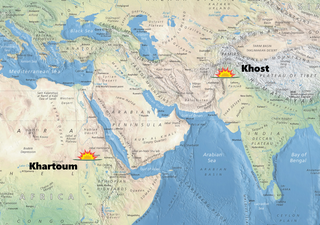Related Research Articles

Al-Qaeda is a Sunni pan-Islamist militant organization led by Salafi jihadists who self-identify as a vanguard spearheading a global Islamist revolution to unite the Muslim world under a supra-national Islamic state known as the Caliphate. Its members are mostly composed of Arabs, but also include other peoples. Al-Qaeda has mounted attacks on civilian and military targets in various countries, including the 1998 United States embassy bombings and the September 11 attacks; it has been designated as a terrorist group by the United Nations Security Council, the North Atlantic Treaty Organization (NATO), the European Union, and various countries around the world.

Osama bin Mohammed bin Awad bin Laden was a Saudi-born militant who was the founder and first general emir of al-Qaeda from 1988 until his death. Ideologically a pan-Islamist, his group is designated as a terrorist group by the United Nations Security Council, the North Atlantic Treaty Organization (NATO), the European Union, and various other countries.

Ayman al-Zawahiri was an Egyptian-born militant and physician who served as the second general emir of al-Qaeda from June 2011 until his death in July 2022.

Operation Infinite Reach was the codename for American cruise missile strikes on al-Qaeda bases that were launched concurrently across two continents on August 20, 1998. Launched by the U.S. Navy, the strikes hit the al-Shifa pharmaceutical factory in Khartoum, Sudan, and a camp in Khost Province, Afghanistan, in retaliation for al-Qaeda's August 7 bombings of American embassies in Kenya and Tanzania, which killed 224 people and injured over 4,000 others. Operation Infinite Reach was the first time the United States acknowledged a preemptive strike against a violent non-state actor.

The Special Activities Center (SAC) is a division of the United States Central Intelligence Agency responsible for covert and paramilitary operations. The unit was named Special Activities Division (SAD) prior to 2015. Within SAC there are two separate groups: SAC/SOG for tactical paramilitary operations and SAC/PAG for covert political action.

The Inter-Services Intelligence is the largest and best-known component of the Pakistani intelligence community. It is responsible for gathering, processing, and analyzing any information from around the world that is deemed relevant to Pakistan's national security. The ISI reports to its director-general and is primarily focused on providing intelligence to the Pakistani government.

Gary Charles Schroen was an American intelligence officer who spent 52 years with the Central Intelligence Agency, most notably as a field officer in charge of the initial CIA incursion into Afghanistan in September 2001 to topple the Taliban and destroy Al-Qaeda. He retired as the most decorated CIA officer in history.
On 13 January 2006 the Central Intelligence Agency fired missiles into the Pakistani village of Damadola in the Bajaur tribal area, about seven kilometres from the Afghan border, killing at least 18 people. Originally the Bajaur tribal area government claimed that at least four foreign members of al-Qaeda were among the dead. United States and Pakistani officials later admitted that no al-Qaeda leaders perished in the strike and that only local villagers were killed. The attack purportedly targeted Ayman al-Zawahiri, second-in-command of al-Qaeda after Osama bin Laden, who was thought to be in the village.
Midhat Mursi al-Sayid Umar, also known as Abu Khabab al-Masri was a chemist and alleged top bomb maker for al-Qaeda and part of Osama bin Laden's inner circle. The United States had a $5 million bounty on his head. Although reportedly killed in a U.S. attack in January 2006, he survived and intelligence officials believe he went on to attempt to resurrect al-Qaeda's program to develop or obtain weapons of mass destruction. On 28 July 2008, Mursi was killed in an American drone attack in South Waziristan, Pakistan.
Saʻd bin ʾUsāmah bin Muḥammad bin ʿAwaḍ bin Lādin, better known as Saad bin Laden, was one of Osama bin Laden's sons. He continued in his father's footsteps by being active in Al Qaeda, and was being groomed to be his heir apparent. He was killed in an American drone strike in 2009.
Osama bin Laden, the founder and former leader of al-Qaeda, went into hiding following the start of the War in Afghanistan in order to avoid capture by the United States and/or its allies for his role in the September 11, 2001 attacks, and having been on the FBI Ten Most Wanted Fugitives list since 1999. After evading capture at the Battle of Tora Bora in December 2001, his whereabouts became unclear, and various rumours about his health, continued role in al-Qaeda, and location were circulated. Bin Laden also released several video and audio recordings during this time.

The Rewards for Justice Program (RFJ) is the counterterrorism and counterintelligence platform administered by the U.S. Department of State's Diplomatic Security Service agency. The Rewards For Justice program is seeking information leading to the arrest, capture, and identification or location of any foreign person, including a foreign entity, who knowingly engaged or is engaging in foreign election interference, as well as information leading to the prevention, frustration, or favorable resolution of an act of foreign election interference. The Rewards for Justice Program has paid more than $250 million to 125 individuals for leading information that prevented international terrorist attacks or helped bring to justice those involved in prior acts.

On May 2, 2011, Osama bin Laden, the founder and first leader of the Islamist militant group al-Qaeda, was shot and killed at his compound in the Pakistani city of Abbottabad by United States Navy SEALs of SEAL Team Six. The operation, code-named Operation Neptune Spear, was carried out in a CIA-led mission, with the Joint Special Operations Command (JSOC) coordinating the Special Mission Units involved in the raid. In addition to SEAL Team Six, participating units under JSOC included the 160th Special Operations Aviation Regiment (Airborne), also known as the "Night Stalkers", and the CIA's Special Activities Division, which heavily recruits from former JSOC Special Mission Units. The success of the operation ended a nearly decade-long manhunt for bin Laden, who was accused of masterminding the September 11 attacks on the United States.
There have been several videos released showing Al-Qaeda leader Ayman al-Zawahiri.

Several sources have alleged that the Central Intelligence Agency (CIA) had ties with Osama bin Laden's faction of "Afghan Arab" fighters when it armed Mujahideen groups to fight the Soviet Union during the Soviet–Afghan War.

After the Central Intelligence Agency lost its role as the coordinator of the entire Intelligence Community (IC), special coordinating structures were created by each president to fit his administrative style and the perceived level of threat from terrorists during his term.
Osama bin Laden, a militant Islamist and reported founder of al-Qaeda, in conjunction with several other Islamic militant leaders, issued two fatawa – in 1996 and then again in 1998—that military personnel from the United States and allied countries until they withdraw support for Israel and withdraw military forces from Islamic countries. He was indicted in United States federal court for his alleged involvement in the 1998 U.S. embassy bombings in Dar es Salaam, Tanzania and Nairobi, Kenya, and was on the U.S. Federal Bureau of Investigation's Ten Most Wanted Fugitives list until his death.

The Inter–Services Intelligence has been alleged or previously documented by various authors of running an active military intelligence program in the United States, as well as operational activities related to America outside the country.

On July 31, 2022, Ayman al-Zawahiri, the leader of the Salafi jihadist group al-Qaeda, was killed by a United States drone strike in Kabul, Afghanistan.
al-Qaeda has five distinct phases in its development: its beginnings in the late 1980s, a "wilderness" period in 1990–1996, its "heyday" in 1996–2001, a network period from 2001 to 2005, and a period of fragmentation from 2005 to 2009.
References
- ↑ Rashid, Ahmed (2012). "A Sliver of Hope: Counterinsurgency in Swat" . Pakistan on the Brink: The Future of America, Pakistan, and Afghanistan. New York, New York: Viking. pp. 148. ISBN 978-0-670-02346-2.
- ↑ "Pakistani agents 'funding and training Afghan Taliban'". BBC News. 2010-06-13. Retrieved 2013-12-09.
- ↑ Priest, Dana (May 15, 2005). "Surveillance Operation in Pakistan Located and Killed Al Qaeda Official". The Washington Post . p. A25. Archived from the original on 2011-02-24. Retrieved April 15, 2007.
The sources said the Predator drone, operated from a secret base hundreds of miles from the target, located and fired on al-Yemeni late Saturday night in Toorikhel, Pakistan, a suburb of Mirali in the province of North Waziristan.
- ↑ Linzer, Dafna; Griff Witte (January 14, 2006). "U.S. Airstrike Targets Al Qaeda's Zawahiri". The Washington Post . pp. A09. Retrieved April 22, 2006.
- ↑ Elizabeth B. Bazan (January 4, 2002). "Assassination Ban and E.O. 12333:A Brief Summary" (PDF). Congressional Research Service. Retrieved April 26, 2006.
- ↑ Tom O'Connor, Mark Stevens (November 2005). "The Handling of Illegal Enemy Combatants". Archived from the original on May 5, 2006. Retrieved April 26, 2006.
- ↑ "Memorandum on Executive Order 12333 and Assassination" (PDF). Archived from the original (PDF) on May 24, 2006. Retrieved April 26, 2006.
- ↑ Jeffrey Addicott (November 7, 2002). "The Yemen Attack: Illegal Assassination or Lawful Killing". Archived from the original on April 18, 2006. Retrieved April 26, 2006.
- 1 2 3 Mark Mazzetti, Dave Rodhe (June 30, 2008). "Amid Policy Disputes, Qaeda Grows in Pakistan". The New York Times. Retrieved June 30, 2008.
- ↑ "C.I.A. Outlines Pakistan Links With Militants", by Mark Mazzetti and Eric Schmitt, July 30, 2008, The New York Times
- ↑ "Pakistan denies 'malicious' report on CIA confrontation", July 30, 2008, Agence France Press Archived 2008-08-05 at the Wayback Machine
- ↑ Walsh, Declan (2010-12-17). "CIA chief in Pakistan leaves after drone trial blows his cover". guardian.co.uk. Retrieved 2010-12-19.
- ↑ Brulliard, Karin; Miller, Greg (2010-12-18). "Top CIA spy in Pakistan pulled amid threats after public accusation over attack". The Washington Post. Washington DC, US. Retrieved 2010-12-19.
- ↑ Rajghatta, Chidanand (2010-12-16). "ISI blows cover of CIA man in Islamabad". The Times of India. Mumbai, India. Retrieved 2010-12-19.
- ↑ "CIA man pulled out of Pakistan amid drone attack storm". Channel 4 News. London, UK. 2010-12-17. Retrieved 2010-12-19.
- ↑ Toppa, Sabrina (April 16, 2015). "Pakistan Could End Up Charging CIA Officials With Murder Over Drone Strikes". Time.
- ↑ Waraich, Omar (7 August 2012). "The CIA and ISI: Are Pakistan and the U.S.'s Spy Agencies Starting to Get Along?". Time.
- ↑ Hersh, Seymour (May 10, 2015). "The Killing of Osama bin Laden". London Review of Books. Retrieved May 11, 2015.
- ↑ "Pakistan Army sends top General to jail, Brigadier to gallows for spying for 'CIA'". ThePrint. Retrieved 31 May 2019.
